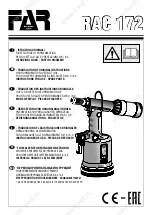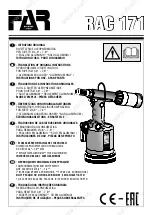
10
3. Quarterly (every 3 months) - Tool disassembly, cleaning, and inspection:
Have the internal mechanism cleaned, inspected, and lubricated by a qualified technician. If the
vanes need replaced, replace them as a set.
TROUBLESHOOTING GUIDE
Symptom
Possible Cause(s)
Corrective Action
Decreased output
Not enough air pressure and/or air
flow
Check for loose connections and make sure
that the air supply is providing enough air flow
(CFM) at required pressure (PSI) to the tool s
air inlet.
Do not exceed maximum air pressure
Obstructed trigger
Clean around trigger to ensure free movement
Incorrect lubrication or not enough
lubrication
Lubricate using air tool oil and grease according
to directions
Blocked air inlet screen (if equipped) Clean air inlet screen of buildup
Air leaking from loose housing
Make sure housing is properly assembled and
tight
Mechanism contaminated
Have qualified technician clean and lubricate
mechanism. Install in-line filter in air supply as
stated in this manual
Housing heats during use
Incorrect lubrication or not enough
lubrication
Lubricate using air tool oil and grease according
to directions
Worn parts
Have qualified technician inspect internal
mechanism and replace parts as needed
Severe air leakage (slight air
leakage is normal, especially
on older tools.)
Cross-threaded housing
components
Check for incorrect alignment and uneven
gaps. If cross-threaded, disassemble and
replace damaged parts before use.
Loose housing
Tighten housing assembly. If housing cannot
tighten properly, internal parts may be
misaligned
Damaged valve or housing
Replace damaged components
Dirty, worn, or damaged valve
Clean or replace valve assembly
WARNING: Follow all safety precautions whenever diagnosing or servicing the tool.
Disconnect the air supply before servicing






























